
Filippino Lippi was an Italian painter working in Florence, Italy during the later years of the Early Renaissance and first few years of the High Renaissance.

Filippo Lippi, also known as Lippo Lippi, was an Italian painter of the Quattrocento and a Carmelite priest. He was an early Renaissance master of a painting workshop, who taught many painters. Sandro Botticelli and Francesco di Pesello were among his most distinguished pupils. His son, Filippino Lippi, also studied under him and assisted in some late works.

Lorenzo Lippi was an Italian painter and poet from Florence.
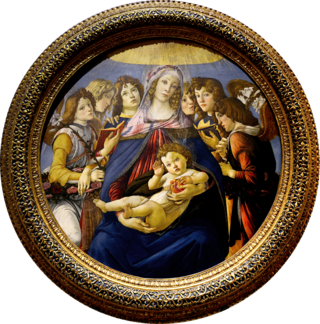
The Madonna of the Pomegranate was painted in circa 1487 with tempera on a wood panel by Sandro Botticelli. It is now in the Uffizi in Florence. Sandro Botticelli was a leading Italian Renaissance artist from Florence, Italy. The Madonna (art) uses the circular format, better known as a tondo, which focuses the attention on the main characters, the Virgin Mary and baby Jesus, who are surrounded symmetrically by angels on each side. Botticelli's use of tempera grassa give the characters a real look, better known as a "naturalistic" style, which is common during the Renaissance. The Virgin Mary is holding baby Jesus gently in her arms while holding a pomegranate in her left hand.

The Madonna of the Book, or the Madonna del Libro, is a small painting by the Italian Renaissance artist Sandro Botticelli, and is preserved in the Poldi Pezzoli Museum in Milan. The painting is executed in tempera on panel. It dates from between 1480 and 1481.

Madonna in Glory with Seraphim is a painting by the Italian Renaissance painter Sandro Botticelli, executed c. 1469–1470. It is housed in Galleria degli Uffizi.

The Virgin and Child with Two Angels is a painting by the Italian Renaissance master Sandro Botticelli, dating to c. 1468–1469. It is in the Museo Nazionale di Capodimonte, in Naples.
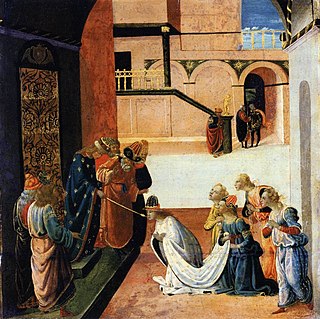
Jacopo del Sellaio (1441/42–1493), was an Italian painter of the early Renaissance, active in his native Florence. His real name was Jacopo di Arcangelo. He worked in an eclectic style based on those of Botticelli, Filippino Lippi, and Domenico Ghirlandaio. The nickname Sellaio derives from the profession of his father, a saddle maker.
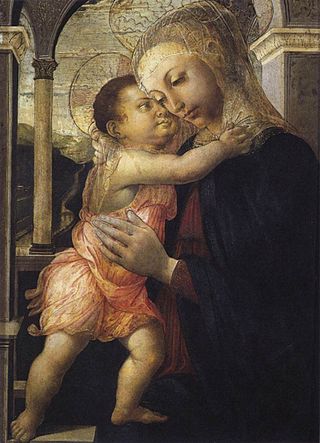
The Madonna della Loggia is a painting attributed to the Italian Renaissance artist Sandro Botticelli, dating to c. 1467. A tempera on panel work, it is located in the loggia of Uffizi, Florence, Italy.

The Madonna del Ceppo is a painting by the Italian Renaissance painter Filippo Lippi, commissioned to him between 1452 and 1453. It is housed in the Civic Museum of Prato, Italy. The name derives from the fact that it was located over a pit of the garden of Pia Casa dei Ceppi in Palazzo Datini, in Prato.
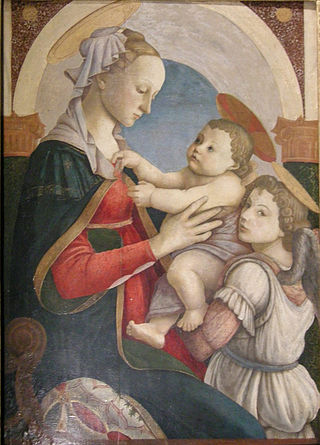
The Madonna and Child with an Angel is a painting by the Italian Renaissance painter Sandro Botticelli, c. 1465–1467. It is housed in Spedale degli Innocenti of Florence.

The Madonna of Palazzo Medici-Riccardi is a painting by the Italian Renaissance artist Filippo Lippi. It is housed in the Palazzo Medici-Riccardi of Florence, central Italy.

The Funeral of St. Jerome is a painting by the Italian Renaissance painter Filippo Lippi of Saint Jerome's funeral. It is housed in the Museo dell'Opera del Duomo next to the Cathedral of Prato, central Italy.

The Virgin and Child with Two Angels is a painting by the Italian Renaissance painter Andrea del Verrocchio, dating from circa 1467–1469. It is in the National Gallery, London, United Kingdom.

Madonna with Child is a painting by the Italian Renaissance artist Filippo Lippi. The date in which it was executed is unknown, but most art historians agree that it was painted during the last part of Lippi's career, between 1450 and 1465. It is one of the few works by Lippi which was not executed with the help of his workshop and was an influential model for later depictions of the Madonna and Child, including those by Sandro Botticelli. The painting is housed in the Uffizi Gallery, Florence, Italy, and is therefore commonly called “The Uffizi Madonna” among art historians.

Lucrezia Buti was an Italian nun who later became the lover of the painter Fra Filippo Lippi and the mother of his children. She is believed to be the model for several Madonnas portrayed in Lippi's paintings.

The Novitiate Altarpiece or Madonna and Child with Saints is a c.1440-1445 tempera on panel painting by Filippo Lippi, now in the Uffizi in Florence. A sacra conversazione, it originally had a predella painted by Pesellino centred on a Nativity. The main panel shows Cosmas and Damian either side of the Madonna and Child, whilst Francis of Assisi is shown at far left and Anthony of Padua at far right. On an architectural frieze above the figures are the Medici's heraldic balls.

Lady the Lambovitissa is a tempera painting by Emmanuel Tzanes. Tzanes was a Greek painter active from 1625 to 1690. His artistic periods can be broken into three parts. The Cretan Period (1625-1647), The Corfu Period (1647-1655), and the Venetian Period (1655-1690). He was a prominent member of the Late Cretan School. His art was heavily influenced by Greek painter Michael Damaskinos. His brothers Marinos Tzanes and Konstantinos Tzanes were both painters. Tzanes has a massive art collection attributed to him nearing over one hundred thirty works. During the Corfu Period (1647-1655), Konstantinos Tzanes and Emmanuel were heavily active. They painted many works on the island.
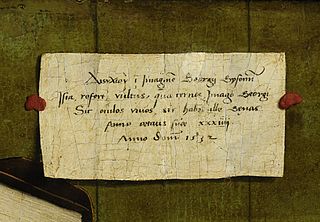
A cartellino is an illusionistic portrayal of a written note included in painting, mostly from the with a legend that records the name of the artist, the date, the subject, or some other relevant information about the work. About 500 Renaissance paintings include a cartellino, but the device has been adopted by some later artists.


















